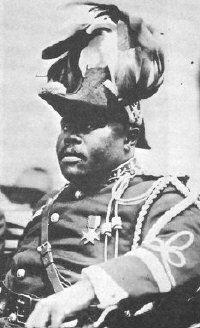

Marcus Garvey, the leader of the Back to Africa movement, arrived in Harlem in 1916, the same year I did. He was 38, an immigrant from Jamaica, and in a short time he became one of the most famous black men in America.
I was 8 years old and living on 133rd Street in Harlem, right in the middle of where the Garvey movement started.
In my neighborhood, there were probably more West Indian than American-born blacks. They wanted to succeed in America, and were very industrious, both husbands and wives -- always trying to start small businesses. They were looking ahead, with the goal of attaining naturalization so they could vote. There was some antagonism between the American-born blacks and the West Indian immigrants. They all wanted to come to the United States because they could live better here. One of them told me that just about every house over there had an outhouse, and didn't have gas, electricity or running water. When they wanted to take a bath on a Saturday, they had to heat a big kettle on the stove. In Harlem, all the buildings had running water and gas, and electricity was coming into a lot of places.
These people used to say they were subjects of the king, and would tell you that back there, they could get jobs that blacks weren't getting here. But they were the lowest-paying jobs, such as petty officials. Well, the first thing we asked them was: "If you could do all those things, why did you leave?" I never heard of any American-born blacks wanting to go there.

I heard a lot about him, and then I started seeing him. They used to have parades along 7th Avenue frequently. Garvey would always be standing up in a big open-top car with his immediate aides riding with him. He dressed like an admiral. He wore one of those cockade hats that admirals wear, and a uniform. There were marchers in front and behind him, carrying banners. The women were in white dresses, and the men wore suits. They probably started about 125th Street, and marched up to 135th and 7th Avenue.
I didn't understand what it meant then. But I think it was all part of trying to attract more members. The dues weren't very much. A lot of black women joined that thing. And just about every woman I met when I was growing up worked as a domestic. They got very, very low wages.
The first thing Garvey did was take all those dollars and form a steamship company, the Black Star Line. The first ship was leaky and unseaworthy, and barely made it out of New York harbor. He sold people on the idea: this is the ship that's going to take you back to Africa and carry on commerce between Africa and here. He later added two more ships, but not one of them ever landed in Africa.
His idea was to set up a colony of American blacks in Liberia. The Liberians first went along with him, but then changed their minds and wouldn't let him in, because they were afraid he would try to take over political power.
The U.S. government wanted to break up the movement because it saw any movement of black people as a threat. The Department of Justice in Washington thought he was trying to start a rebellion, so they accused him of bilking poor working people, and arrested him on several fraud charges for collecting the money to buy the steamers and to start other commercial businesses. He was tried in federal court and jailed in Atlanta, then later deported to Jamaica.
Two of Garvey's biggest enemies were W.E.B. Du Bois, editor of the NAACP's magazine The Crisis, and Philip Randolph, editor of the Messenger, a socialist weekly paper, and founder of the Brotherhood of Sleeping Car Porters. They thought the Back to Africa movement was a harebrained idea -- just like I think.
The idea didn't occur among any blacks here because Du Bois and all of them saw how utterly ridiculous it was. Garvey was taking advantage of people with low education and low-paying jobs.
Garvey had a dream, but I don't think the Back to Africa movement was ever possible. How was he going to get enough money to move all the blacks back to Africa? And nobody wanted to go over to Africa.
But Garvey still has a lot of supporters today. There are Garvey societies throughout the United States and in other countries, and the biggest park in Harlem has been renamed Marcus Garvey Park.